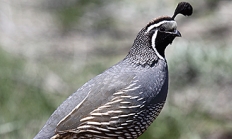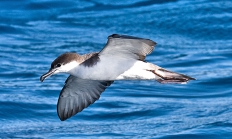Search myodfw.com
An Oregon native, sooty grouse occupy the coniferous forests of western Oregon, the eastern slopes of the Cascades, the Blue Mountains of northeastern Oregon, and the Klamath Basin and South Warner Mountains. Preferred habitat includes timber edges, open timbered slopes and mountain meadows, often adjacent to springs or other sources of water. They are often associated with berry producing areas such as chokecherry thickets. Hear the call of the sooty grouse Photo by ©Keith Kohl, ODFW

Columbian sharp-tailed grouse, commonly called "prairie chickens" by early Oregon residents, were abundant in the grasslands and foothills of Oregon east of the Cascade Mountains prior to the late 1800s but were considered extirpated from the state by the 1970s. Recent reintroduction programs give a glimmer of hope that sharp-tails may once again hold their own in northeast Oregon. Males congregate on leks or dancing grounds in the spring and perform elaborate social displays. The Columbian sharp-tailed grouse is an Oregon Conservation Strategy Species in the Blue Mountains ecoregion. Hear the call of the Columbian sharp-tailed grouse Photo by Mike

This is the largest native quail in North America and one of the least understood. Males and females have identical plumage characterized by distinctive white flank barring and prominent vertical head plumes. Their eastern Oregon range appears reduced from historical accounts. Mountain quail are considered occasional in Union and Wallowa counties. They have also been observed along many of the tributaries of the John Day River in Wheeler and Grant counties and some in Wasco, Jefferson, Deschutes and Crook counties. In western Oregon, they are found in most forested mountainous areas generally above 1,640 feet, but may move to valley

California quail are the most widely distributed upland game birds in Oregon. Most easily recognized by the comma-shaped, black, plume, or "topknot," which bends forward and is larger on the male. It has been a resident statewide since the early 1900s, except for most forests of the north Coast Range and west Cascades; it is generally absent along the coast north of Coos Bay. California quail is also absent from high-elevation areas of the east Cascade range. They are common residents in rural and even some suburban areas, particularly in eastern Oregon where many coveys gather at feeding stations during

These diving birds are built for living on the water, floating low on the surface with legs farther to the rear to help propel them underwater. Loons have webbed feet, grebes have lobed toes.

A small loon holding its slender head erect and narrow, upswept bill upward is most always a red-throated. A quick flyer, it can be identified by rapid deep wing-beats, humpbacked body with head and neck extending below the body, and wings appearing far to the rear due to the usual invisibility of the small feet. Often feeding near the surf, it may be spotted by beachcombing humans. It can take flight from a small water area, and can also, if pressed, take flight from land. It is an abundant Oregon nearshore transient from fall through spring. Hear the call of

The flight of Pacific loons by the thousands along the coast each spring and fall is one of Oregon's most dramatic bird migrations. Stunning plumage often clothes these fast-flying travelers. The straight bill, distinguishing Pacific from red-throated and yellow-billed, is less robust than that of common loons. The Pacific's head is larger and its neck thicker than those of the red-throated. In flight, Pacific's wing-beats are faster than those of common, loons the feet appear larger, the forecrown is rounder, and the hindcrown more sloped than those of red-throated loons. This is the most abundant loon off the Oregon coast

This largest of the commonly encountered loons is perfectly built for underwater prey pursuit. Ungainly on land, this may be the price it pays for being a great diver. Large and blocky-headed, with a straight, robust bill, the common loon is separated from the yellow-billed by its straight bill and winter face pattern, and from smaller loons by its more angular head and often-retracted robust neck. Black head, white "necklace," incomplete black-and-white neckband, and white-checkered black back define breeding adults. Dark gray upperparts of winter adults shade to white underparts. Take-off is impossible by land and labored on water, but

This large loon breeds in the Arctic tundra from Northwestern Russia across Siberia and Alaska through Canada to Hudson Bay. It winters in North America along the coast of South Alaska and British Columbia, and regularly in small numbers south to Baja, California. The majority of Oregon records are of transient birds found between early November and early June. Hear the call of the yellow-billed loon Photo by Mark Peck, Flickr

The pied-billed grebe is an aquatic species that breeds at the edge of open water in freshwater lakes, ponds, sluggish rivers, and marshes. When disturbed, it sinks like a submarine, rather than diving, and re-emerges with only its head above water. This is a brownish grebe with a black vertical bar in the middle of the rather stubby, whitish bill, and jet-black throat patch on both sexes in alternate plumage. It has a surprisingly loud "yelping" call within a marsh. Young have striking stripes on the head. This bird is widespread and common in Oregon. It winters locally in open

This salt-loving bird is possibly the most abundant grebe in the world. These grebes nest in the large, tule-fringed marshes of southeastern Oregon. They also use almost any open water for feeding after the breeding season. The eared grebe has been reported breeding in nearly every eastern Oregon county, but principal breeding areas are in Klamath, Lake, and Harney counties. It is local elsewhere east of the Cascades. Hear the call of the eared grebe Photo by Dave Budeau, ODFW

The largest of Oregon's grebes, these have a long white neck, black cap, bright red iris, long strait bill, dark back, bright white breast, and they appear tailless. While excellent divers, they are unable to walk on land because their body weight is forward of their legs. Differences in appearance between western and Clark's grebes are subtle. In the western grebe, the black cap typically extends down to the eye whereas white facial plumage extends slightly above the eye on the Clark's grebe, but this is not always diagnostic in winter. The western grebe is a common breeder in eastern

Clark's grebe is very similar in plumage, habitat, and behavior to the western grebe. It breeds in inland lakes with emergent vegetation such as cattails and tules. It requires open water for foraging on the surface or diving below in pursuit of fish. It winters both along the seacoast and on major rivers. Like the western grebe, Clark's grebe is a specialist in fish, which make up over 80 percent of its diet. It will also eat other aquatic organisms like crayfish, amphibians, and aquatic insects. Its breeding range in Oregon overlaps that of western grebe, but Clark's is not

Popularly called "Gooneybird" for its elaborate mating antics and clumsy takeoffs and landings and breeding islands, this is a large, spectacular seabird. Though small for an albatross, it glides on wind currents just above the ocean waves on long narrow wings which span approximately six-and-a-half feet. The dark gray wings, back and tail contrast with a white body and upper tail coverts. Singles or small groups are reported occasionally on offshore Oregon birding trips, primarily in winter. Hear the call of the Laysan albatross Photo by ©Greg Gilson

A big, well-mannered bird of friendly, even playful disposition, with an abundant curiosity as to human presence and activities within the realm of open ocean over which he presides. Long-winged, to seven feet, and dark sooty-brown; adults have a white rump and feathering, which juveniles lack, around the base of a large bill. Every sighting of these gentle giants gliding up to the boat evokes delight. The black-footed albatross is a regular visitant spring through fall offshore, but is irregular in winter. They glean squid, fish and fish eggs from the ocean surface and also eat galley scraps. Hear the

One of Oregon's characteristic offshore seabirds, these stocky gull-like birds with steep foreheads come in a broad range of color morphs from white to slate gray, with buffy, bluish-gray, mottled and brown intermediates. The round head and pecking motion of birds feeding on the water is reminiscent of the shape and behavior of pigeons. The heavy hooked bills are divided into colorful plates of green, yellow, and orange, with large tubed nostrils atop. They are irregularly common to abundant in Oregon in winter, especially beyond five miles from shore. Hear the call of the Northern fulmar Photo by Martyne Reesman

The mottled petrel breeds in New Zealand and nearby islands, and ranges throughout much of the Pacific Ocean, mostly far from land. It is a common May to October visitant in the northern and eastern North Pacific, with non-breeding birds occurring during the winter months. Photo by Dominique, Flickr

The world population of this species, which probably does not exceed 25,000 pairs, is quite low for a seabird. Nevertheless, these are the common light-bellied shearwaters off Oregon in summer. They are larger, bulkier, and fly more deliberately than the usually much more abundant sooty shearwaters with which they associate. They are uniform gray-brown above; the underparts are white; the vent and underwings variably smudged with dusky. The pinkish bill is dark-tipped and the feet are pink. It is a common summer visitor and very common fall transient offshore on shallow shelf waters. It is usually seen seaward, approximately five

Flesh-footed shearwaters are always exciting birds to find, as they are one of the rarest of the seabirds to occur annually in Oregon. Single birds are sometimes found in flocks of other shearwaters. They are very similar to sooty shearwaters but they are larger with pink or pale whitish feet and dark-tipped pale bills. In addition, their plumage is a deep chocolate-brown, lacking the grayness of the upperpart coloration of sooty shearwaters; and the underwing does not show the sooty's white coverts. It is a rare late fall transient offshore at the western edge and slopes of the continental shelf

Few seabirds have been labeled "stunning;" but with their graceful flight, boldly patterned upperparts, and brilliant white underparts, these birds truly are one of the most beautiful in Oregon waters. They have a black cap, wings angled forward, long body and tail, and a unique dark 'M' pattern against light gray back and wings. Often seen in small groups mixed among other more abundant shearwaters, they sometimes form pure flocks all flying in gracefully synchronized flight. While regular in Oregon in late fall, they are still uncommon enough to excite observers when encountered at sea. Photo by Tony Morris, Flickr

